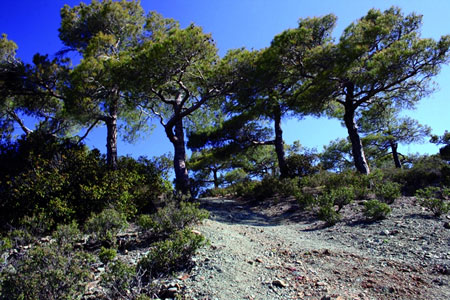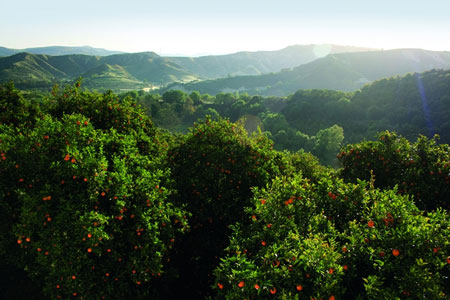Article content
21 August 2012 by Alex Stewart
Duncan Mills follows the ancient walking trails of Cyprus and discovers the rugged landscape and traditional villages of this charming destination.
The path winds slowly uphill, a track of loosely chipped limestone and ochre earth that leads between gnarled olive trees and flowering gorse bushes that cast bright yellow sparkles across the Akamas Peninsula. Agama lizards scuttle across the pathway and then stop on sun-baked rocks. All looks as it must have done to the people who have followed the walking trails of Cyprus for centuries: crusaders and invaders, farmers and fishermen, classicists and conservationists; Byzantines, Venetians, Ottomans, British, Greeks and Turks.
Butterflies skitter on a breeze that carries with it a hint of wild sage. The bone-white branches of juniper trees lie scattered around after unseasonable rains, like the antlers of stags discarded after a tussle in the mating season. Partridges and seabirds chirp amid the yellow-green, which forms a striking contrast to the deep blue, cool grey and chalky white down below, where lapping waves meet small, rocky coves. Around the headland are more sheltered beaches, where hawksbill and green turtles return each summer to nest - safely for now, though the pressure to build tourist hotels and other developments on this peninsula is mounting, despite the warnings of environmentalists.

Legends were formed along these pathways, too. Aphrodite, the goddess of beauty, is said to have bathed and seduced her many lovers in the Akamas area. These included Adonis, who later died in her arms (the poppies in the meadows further inland are said to represent his spilt blood), and sections of the route around the peninsula are named after them - the Adonis and Aphrodite trails. Both are part of a centuries-old walking network that has been incorporated into the European long distance path E4 - which starts in Gibraltar and passes through Spain, France, Switzerland, Germany, Austria, Hungary, Bulgaria and Greece.
In Cyprus, it connects Akamas in the west with Agia Napa in the east, via the towering Troodos Mountains and a rural heartland much removed from the bustle of most of the coastline. The few remaining moufflons (wild sheep) roam the uppermost reaches and the highest peak, Olympus, shares its name with the mythical home of the gods on the Greek mainland. It's blanketed with snow in winter and there's enough left on this spring day for some Cypriot daytrippers to have a snowball fight.

Away from the snowline, pine trees and cedars form a watercolour wash of green under the midday sun. Purple, yellow and white spring flowers line the Madari Trail, which snakes its way to a rocky summit that overlooks a broad treeless plain called the Mesaoria. The word means 'between the mountains', but the plain has for the past few decades also formed a political buffer zone between the Greek South and Turkish North, on a border commonly known as the Green Line, after it was drawn on a map in green crayon by a British army officer.
The division remains an emotive issue, as my guide Christos explains as we walk along a ridge overlooking the Mesaoria. He is now able to visit the North, he says, but doesn't truly feel free there, more like a tourist than someone in his own country. He tells me a little of the story of the Turkish invasion of 1974, describing how the beach resort of Famagusta was taken by the Turks. The Greek Cypriots left everything as they fled and it remains a ghost town even now.
"We used to all live together. I hope we can find a solution for everyone," he says, just before pointing out some white flowers clinging to the rocky path. "Virgin's tears," he calls them.

Despite the divide, parts of the Troodos feel like they've hardly changed in generations. There are small mountain villages where the branches of orange trees hang heavy with fruit. My guidebook describes Cypriot village life as being 'under the shade of a tree of idleness' and this is especially true in the village cafes, where old men, smartly dressed in suits or blazers, gather to sip earthy black coffee, gesticulate over games of cards or backgammon, and gossip about their wives, politics and football.
The villagers of Kalopanayiotis, however, have recognised the potential for rural tourism. Their pretty village straddles a wooded river valley and much of it is being restored and redeveloped as part of a collective initiative by the villagers, with boutique accommodation being built in sensitively restored traditional stone buildings with tiled roofs and wooden balconies. Other buildings contain a spa and a restaurant, making it a small but self-contained place to base oneself while seeing the nearby sights.
Across the river is the simple stone church of Agios Ioannis Lampadistis, one of a group of ten Byzantine churches in Cyprus on UNESCO's World Heritage list. A simple cross high up in the brickwork is the only real indication from the outside of its use - and that was part of the intent: monks and citizens built churches far from the coast in order to protect the treasures within from Arab raids.

Inside, in a dimly lit series of alcoves and domed rooms, is a series of priceless frescoes, aged and delicate, showing scenes from the Last Supper and of the betrayal of Jesus by Judas. Others depict Byzantine priests in robes bearing the cross of St George. It feels like a fabulous discovery. Close by is another church in the village, beside an ancient oak tree in whose branches handkerchiefs and strips of lace have been tied in prayer and for good luck, and which has a church bell nestled in a fork between its boughs. The church interior is less ornate, with one or two frescoes and artefacts, and a waft of candle smoke.
I spend the night in an agrotourism hotel in the mountain village of Ambelikkos, tucking into meze made with ingredients from the kitchen garden and surrounding region: homemade bread with creamy tzatziki; Greek salad with generous cubes of milky white and crumbly feta; dark sausages cooked in wine; salty halloumi cheese grilled and coated with sweet fig jam; vine leaves stuffed with rice, tomatoes and musty spices; dishes of marinated rabbit and pork; aubergines and eggs; and succulent lamb slowcooked with potatoes in a clay pot. Crisp and lemony Xynisteri white wine, made from grapes grown on the terraced slopes of the Troodos - the legacy of 5,000 years of viniculture in Cyprus - is the perfect accompaniment to this rustic feast, followed by a gulp of breath-stealing 'firewater' as a final flourish.

Afterwards I step outside to admire a night sky full of stars and the outline of houses and the domed village church in the moonlight. The next morning I watch as dawn stretches lazily across the valley, slowly spreading warmth and light across the orchards and vineyards, farmhouses and church. A bird chirrups. As we listen, my driver, Zacharious, looks at me, and smiles. The bird's name in Cypriot means 'happy', he tells me, and tradition has it that if it comes to your house you will be blessed with happiness. It bodes well, whichever path we choose to follow today.

Article originally published in
Vol 42, No3, 2012
(Photos by the author)






